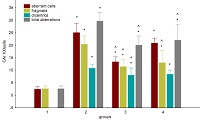Haberlea rhodopensis (Friv.) reduces chromosomal aberrations in whole body irradiated rabbits
Keywords:
chromosome aberrations, Haberlea rhodopensis, radioprotectionAbstract
Radioprotective effect of ethanolic extract of Haberlea rhodopensis have been studied by examining chromosome aberration in irradiated rabbits. Healthy adult New Zeland rabbits were injected intramuscularly (im) with 120 mg/kg body weight before and after irradiation or with double distilled water (DDW). They were exposed to whole body irradiation of 2.0 Gy gamma rays. After 24 h chromosomal aberrations were studied in the peripheral blood lymphocytes. Radiation (2.0 Gy) increased the number of aberrant cells from less than 3% in controls to almost 25%. Treatment with the total extract of Haberlea rhodopensis (HR) before and after irradiation resulted in a significant reduction in the percentage of aberrant metaphases as well as in the different types of aberration scored. Our results proved the ameliorating role of HR against radiation-induced chromosomal aberrations in rabbits.Further experimental studies using different cytogenetic and molecular biomarkers are needed to clarify the exact mechanisms of radioprotective action of the HR extract
References
. Nair CK, Parida DK, Nomura T.
Radioprotectors in radiotherapy. J.
Radiat. Res. 2001; 42: 21–37.
. Jagetia GC and Reddy TK.
Modulation of radiation-induced
alteration in the antioxidant status
of mice by naringin. Life Sci. 2005;
:780–794.
. Patt HM, Tyree EB, Straube HL,
Smith DE. Cysteine protection xirradiation. Science. 1949; 110:213.
. Bacq ZM, Herve A, Lecomte J, Fisher
P, Blavier J, Dechamps G, Lebihan
H, Rayet P. Protection contre Le
rayonnement-x par La-β-
mercaptoethylamine. Arch. Int.
Physiol. 1951; 59: 442-447.
. Withers HR, Elkind MM. Microcolony
survival assay for cells of mouse
intestinal mucosa exposed to
radiation. Int J Rad Biol. 1970;
:261.
. Bhattacharya S, Banerjee D, Bauri
AK, Chattopadhyay S,
Bandyopadhyay SK. Healing
property of the Piper betel phenol,
allylpyrocatechol against
indomethacin-induced stomach
ulceration and mechanism of action.
World J Gastroenterol.
;13(27):3705-3713.
. Emerit I, Arutyunyan R, Oganesian N,
Levy A, Cernjavsky L, Sarkisian T,
Pogossian A, Asrian K. Radiationinduced clastogenic factors:
Anticlastogenic effects of Ginkgo
biloba extract. Free Radic. Biol.
Med. 1995;18:985–991.
. Sharma J, Sharma R.
Radioprotection of Swiss albino
mouse by Centella asiatica extract.
Phytother. Res. 2002;16:785–786.
. Uma Devi P, Ganasoundari A.
Radioprotective effect of leaf extract
of Indian medicinal plant Ocimum
sanctum. Ind. J. Exp. Biol.
;33:205–209.
. Salin CA, Samanta N, Goel HC.
Protection of mouse jejunum against
lethal irradiation by Podophyllum
hexandrum. Phytomedicine.
;8:413–422.
. Hari Kumar KB, Kuttan R. Protective
effect of an extract of Phyllanthus
amarus against radiation-induced
damage in mice. J. Radiat. Res.
;45:133–139.
. Markovska YK, Tsonev TD,
Kimenov GP, Tutekova AA.
Physiological changes in higher
poikilohydric plants - Haberlea
rhodopensis Friv. and Ramonda
serbica Panc. during drought and
rewatering at different light regimes.
J Plant Physiol. 1994;144: 100.
. Mihailova D, Bahchevanska S,
Toneva V. Microwave-assisted
extraction of flavanoid antioxidants
from leaves of Haberlea
Rhodopensis. Journal of
International Scientific Publications:
Materials, Methods & Technologies.
; 5 (1):104-114.
. Popov B, Radev R, Georgieva S. In
vitro incidence of chromosome
aberrations in gamma-irradiated
rabbit lymphocytes, treated with
Haberlea rhodopensis extract and
vitamin C. Bulg J Vet Med. 2010; 13,
(3) 148-153.
. Popov B, Georgieva S, Gadjeva V.
Modulatory effects of total extract of
Haberlea rhodopensis against the
cyclophosphamide induced
genotoxicity in rabbit lymphocytes in
vivo. Trakia Journal of
Sciences.2011; 9 1:52-58.
. Popov B, Georgieva S, Gadjeva V,
Petrov V. Radioprotective,
anticlastogenic and antioxidant
effects of Haberlea Rhodopensis on
rabbit blood samples exposed to
gamma radiation in vitro. Revue
Méd. Vét., 2011; 162, 1:34-39
. IAEA, 2001. Cytogenetic analysis for
Radiation Dose Assessment.
Technical Report.
. Popov B: antimutagenic potential of
Haberlea rhodopensis total extract,
PhD thesis, Trakia University,
Department of Molecular Biology,
Immunology and Medical Genetics,
. Evans EJ. Human peripheral blood
lymphocytes for the analysis of
chromosome aberrations in
mutagen test. In: Kilbey B, Legator
M, Nichols W, Ramel C. editors.
Handbook of mutagenisiti test
procedures, Elsevier, Amsterdam,
p.405.
. Jagetia GC, Venkatesh VA.
Treatment of mice with stem bark
extract of Aphanamixis polystacha
reduces radiation induced
chromosome change. Int. J. Radiat.
Biol. 2006; 82:197-209.
. Krishna A, Kumar A. Evaluation of
radioprotective effects of
Amaranthus paniculatus extract in
swiss albino mice J. Radiat.
Res.2005;46:233-239.
. Ivanov V, Radev R, Sokolova K,
Tsokeva ZH, Pyrovski L. Antioxidant
activity of total extract of Haberlea
rhodopensis (Friv.). International
Science conference 4th - 5th June
, Stara Zagora, Bulgaria. 2009;
: 50-52.
. Berkov SH, Nikolova MT, Hristozova
NI, Momekov GZ, Ionkova I,
Djilianov D. GC–MS profiling of
bioactive extracts from Haberlea
rhodopensis: an endemic
resurrection plant, J Serb Chem
Soc. 2011; 76 (2):211-220.
. Shimoi K, Masuda S, Furugori M,
Esaki S, Kinae N. Radioprotective
effects of antioxidative plant
flavonoids in mice, Mutat Res. 1996;
:153.
. Shimoi K, Masuda S, Shen B,
Furugori M, Kinae N.
Radioprotective effect of
antioxidative flavonoids in gammaray irradiated mice. Carcinogenesis.
; 15: 2669-2678.



